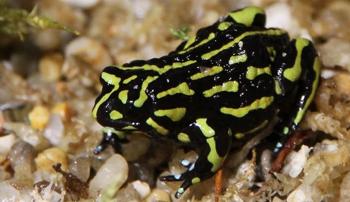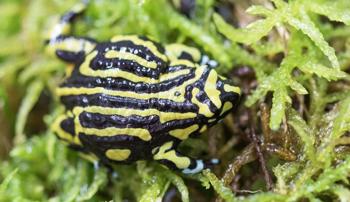Northern Corroboree Frog
This little frog’s vivid lime green stripes separate it from the yellow striped Southern Corroboree Frog, but they are both at risk in the wild.
The Northern Corroboree Frog lives in the forests, sub-alpine woodlands and tall heathlands of the ACT’s Brindabella Ranges and the nearby Fiery Range and Bogong Mountains in NSW. The frogs are only 2.5-3cm in length. Although not as rare as their southern relatives, populations of the Northern Corroboree Frog have greatly declined in the last few decades.

The major threats
The disease Chytridiomycosis, caused by chytrid fungus infection, is fatal to all frogs. The Northern Corroboree Frog is also affected by damage to its breeding sites by feral animals, fire, drought, weeds and logging. Climate change could also lead to the loss of breeding pools.

The plan for fighting extinction
Zoos Victoria is breeding Northern Corroboree Frogs to support wild populations. A large number of fertile eggs has already been released into the wild. Our monitoring program will help us better understand the differences between the two species of Corroboree Frog.
How you can help
- Encourage the purchase of phosphate free detergents and cleaners to improve the health of our waterways.
- Donate if you can. Every little bit helps. We are a not-for-profit organisation, so all donations go towards our important conservation efforts.
- By visiting our zoos, you are be supporting our work to fight extinction.
The Northern Corroboree Frog Project is supported by the Australian Government’s National Environmental Science Program through the Threatened Species Recovery Hub and funding from the Australian Government’s Bushfire Recovery Program for Wildlife and their Habitats. Zoos Victoria is grateful for funding support towards this project from Cadbury’s Save The Frogs initiative.
Discover more about local conservation events and join the wild activists taking action for local wildlife.
Is your classroom learning about the Northern Corroboree Frog?
Browse through our collection of animal teaching and learning resources for students. These include animal toolkits, e-books, Ask a Zoo Expert resources, video showcases and real-world examples to support the VCE Study Design.
